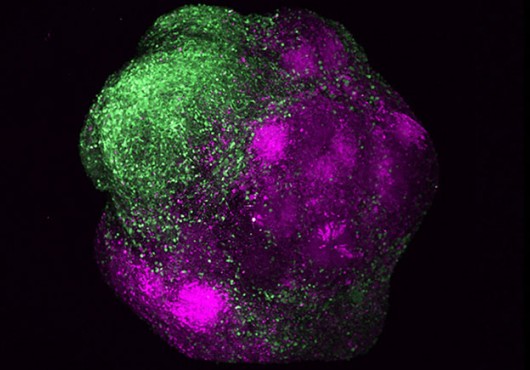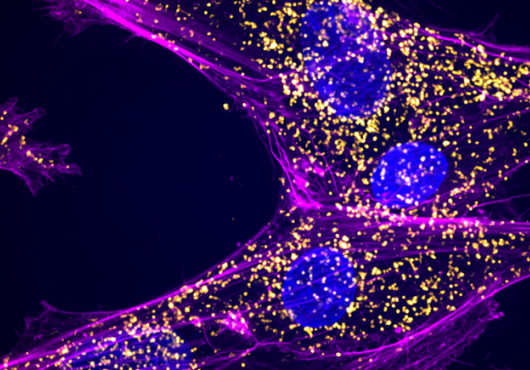
By taking a deep dive into the molecular underpinnings of Diamond-Blackfan anemia, scientists from Harvard Medical School and Boston Children’s Hospital have made a new discovery about what drives the development of mature red blood cells from the earliest form of blood cells, called hematopoietic (blood-forming) stem cells.
For the first time, cellular machines called ribosomes, which create proteins in every cell of the body, have been linked to blood stem cell differentiation.
The findings, published online in Cell on March 15, reveal a potential new therapeutic pathway to treat Diamond-Blackfan anemia. They also cap off a research effort spanning nearly 80 years and several generations of scientists at HMS and Boston Children’s.
Local history
Diamond-Blackfan anemia—a severe, rare, congenital blood disorder—was first described in 1938 by Louis Diamond and Kenneth Blackfan of HMS and Boston Children’s. The disorder impairs red blood cell production, impacting delivery of oxygen throughout the body and causing anemia.
Forty years ago, David G. Nathan, the HMS Robert A. Stranahan Distinguished Professor of Pediatrics at Dana-Farber/Boston Children’s, determined that the disorder specifically affects the way blood stem cells become mature red blood cells.
Then, nearly 30 years ago, Stuart Orkin, the HMS David G. Nathan Distinguished Professor of Pediatrics at Dana-Farber/Boston Children’s, identified a protein called GATA1 as being a key factor in the production of hemoglobin, the essential protein in red blood cells that is responsible for transporting oxygen. In more recent years, genetic analysis has revealed that some patients with Diamond-Blackfan have mutations that block normal GATA1 production.
Now, the final pieces of the puzzle—what causes Diamond-Blackfan anemia on a molecular level and how exactly ribosomes and GATA1 are involved—have been solved by Vijay Sankaran, HMS assistant professor of pediatrics at Boston Children’s.
“Much of the history of how this disorder works was written at Boston Children’s,” said Sankaran, senior author of the new paper and a hematologist/oncologist at the Dana-Farber/Boston Children’s Cancer and Blood Disorders Center. “Now, we can move on to the next era of research: what we can do to treat it.”
Learning from an error of nature
Previous studies found that many patients with Diamond-Blackfan anemia have mutated ribosomal protein genes. But the questions have remained: Do these mutations have something to do with GATA1? Why do they only impair the maturation of red blood cells?
In Diamond-Blackfan, other mature blood cells—such as platelets, T cells and B cells—still fare well despite mutations of ribosomal protein or GATA1 genes.
“There has been controversy over whether a ribosomal protein mutation changes the composition of the ribosomes or the quantity of the ribosomes,” Sankaran said. “We know now that it is the latter.”
By closely examining human cell samples from patients with Diamond-Blackfan, Sankaran and his collaborators found that the quantity of ribosomes within blood cell precursors directly influences their ability to produce effective levels of GATA1, which is needed for hemoglobin production and for red blood cell production.
Tying all the pieces together, Sankaran and his team showed that a reduced number of ribosomes slashes the output of GATA1 proteins inside blood stem cells, impairing their differentiation into mature red blood cells.
Opportunity for gene therapy
The team’s finding supports the hypothesis that the presence of GATA1 proteins in early blood stem cells helps prime them for differentiation into red blood cells.
Without enough ribosomes to produce enough GATA1 proteins, these early cells simply never receive the signal to become red blood cells.
“This raises the question of whether we can design a gene therapy to overcome the GATA1 deficiency,” said Sankaran. “We now have a tremendous interest in this approach and believe it can be done.”
Although a bone marrow transplant from a matched donor can treat Diamond-Blackfan anemia, Sankaran says that a gene therapy would be advantageous since it would use a patient’s own engineered cells, avoiding dangerous risks associated with graft-versus-host disease.
“I think what’s great is that we can learn about developmental biology just by looking at our own patients very carefully,” said Sankaran. “Genetic errors can give us the chance to pick apart the complex pieces of health and discover how they relate to one another.”
This research was supported by the National Institutes of Health (DK103794, R33HL120791 and T32HL007574), a Manton Center Endowed Scholar Award, a Diamond Blackfan Anemia Foundation and March of Dimes Basil O’Connor Scholar Award, a Boehringer Ingelheim Fonds MD Fellowship, the Swiss National Science Foundation, the Novartis Foundation, Olga Maybenfisch Stiftung and the European Research Council (EURIBIO260676).
Adapted from a post on Vector, the Boston Children’s clinical and research innovation blog.





